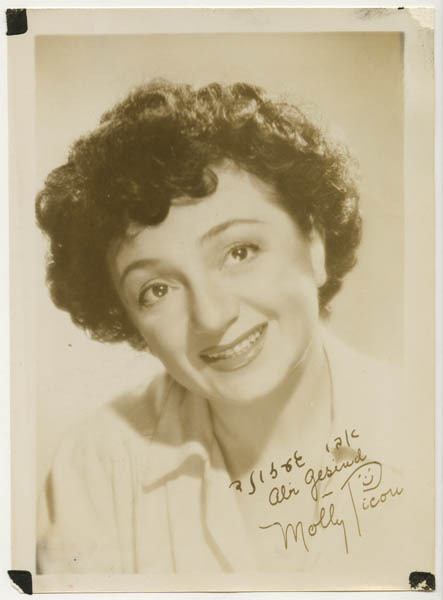We’re delighted to kick off a series close to our hearts: the story of Molly Picon, for decades a household name in Yiddish theater and vaudeville, then a Broadway star, performer with the USO and radio personality–not to mention Yente the Matchmaker in Fiddler in the Roof. Some called her "the Jewish Charlie Chaplin"; others, “the Jewish Helen Hayes.” We think she stands grandly on her own.
Former Center for Jewish History intern Sarah Ganton follows the story of her life as told through the archives of the American Jewish Historical Society, one of the five partners of the Center of Jewish History. Join us in celebrating this remarkable, vivacious, and endlessly talented woman. And don’t miss the next installment in our series, “The Molly Picon Story, Part 2: A Star (and a Romance) Is Born.”

Autographed headshot of Molly Picon, undated. From the Collection of the American Jewish Historical Society.
In 1943, approximately forty years into Molly Picon’s long and storied career, Louis Nizer wrote of her: “I suspect she is the Joan of Arc of the Yiddish Theatre. She is the glorious, heroized personification of her people’s joy and tears, their song and dance, their versatility and charm. That is why she is their darling. They pay her tribute because she is a living tribute to them.”[1] Though modern audiences may only remember her as Yente the matchmaker in the hit film Fiddler on the Roof, it is obvious from her collection of papers in both the AJHS and YIVO that she was much more than that.
Molly Picon was born in New York on either February 28 or June 1, 1898. In her autobiography, Molly!, she writes, “Various records list me as having been born either February 28th or June 1st. Naturally, I celebrate both dates.”[2] Her father, Louis Picon, was in fact married to both her mother, Clara Ostrovsky, and a previous wife in his home country of Poland, and thus was not present for much of Molly’s and her younger sister Helen’s childhoods. Clara, known as Mama Picon and her daughters soon left New York to move in with her parents, living in a home with two grandparents, the Picons, and eight or nine of Molly’s cousins.
By her own description, Molly was “a small skinny kid who loved to kibbitz with the neighbors.”[3] While her mother sewed costumes for the Columbia Theater, Molly kibbitzed away, learning song and dance routines from her neighbors and performing duets with her mother in their living room. Present at one such performance were actors from a Yiddish theater troupe for whom Clara was fitting costumes, and they convinced Mama Picon to put her daughter on the stage.
Mama Picon sewed Molly a fancy new dress and off the duo went on the trolley car to the Bijou Theater, where amateur night was every Friday night and children could perform for talent scouts. But Molly’s first professional performance, like much in her life, was anything but ordinary. On the trolley car she and Mama Picon encountered a skeptical drunk, and little Molly proved right then and there that she was a force to be reckoned with: “I got up in the car and did my whole act…Then the drunk took off his derby and passed it around to the people in the car and collected two dollars in coins, which he gave to me. So I consider that my first professional performance.”[4] Molly went on to win Amateur Night at the Bijou Theater in effectively her second professional performance, earning a five-dollar prize and a new stage name: Baby Margaret. Baby Margaret soon became the consummate vaudeville professional, singing in English and Dutch, dancing traditional Russian dances, playing whatever child’s part came her way in plays at the Columbia Theater, and, notably, playing Topsy in Uncle Tom’s Cabin in both Yiddish and German.
She was young yet, but Molly knew she had found her lifelong career: “Something inside me shone bright and clear, and I knew I would stick to the theater all my life…as the wardrobe mistress’ daughter, I got a love of the stage because there I could make believe I was all the things I could never be in real life.”[5] Indeed, Molly would leave high school after two years to tour on the vaudeville circuit full time, where we will catch up with her in the next post.
Sarah Ganton is a former intern at the Center for Jewish History.
Next in our series:
The Molly Picon Story, Part 2: A Star (and a Romance) Is Born
Sources:
1. Louis Nizer, writing in a program for a reception honoring MP, given by the Ladies Welfare League of the Yiddish Theatrical Alliance at the Molly Picon Theatre, 1943 (AJHS MP Papers, box 50 folder 1051). Link to the finding aid.
2. Picon, Molly with Jean Grillo. Molly! An Autobiography. New York: Simon and Schuster, 1980. pg. 109.
[1] Louis Nizer, writing in a program for a reception honoring MP, given by the Ladies Welfare League of the Yiddish Theatrical Alliance at the Molly Picon Theatre, 1943 (AJHS MP Papers, box 50 folder 1051)
[2] Picon, Molly with Jean Grillo. Molly! An Autobiography. New York: Simon and Schuster, 1980. pg. 109.
[3] Picon, 14.
[4] Picon, 15.
[5] Picon, 20.
